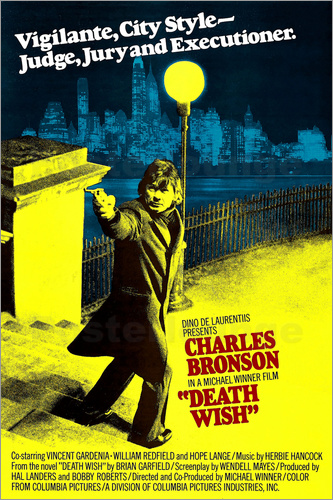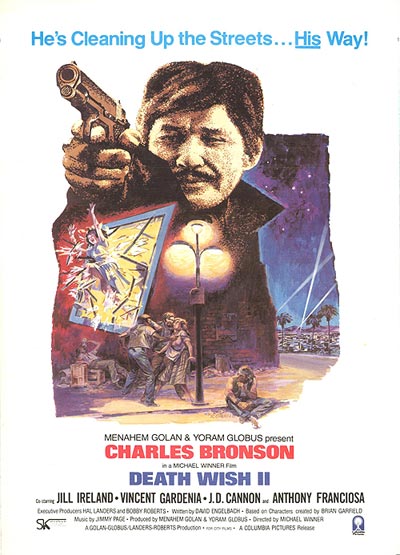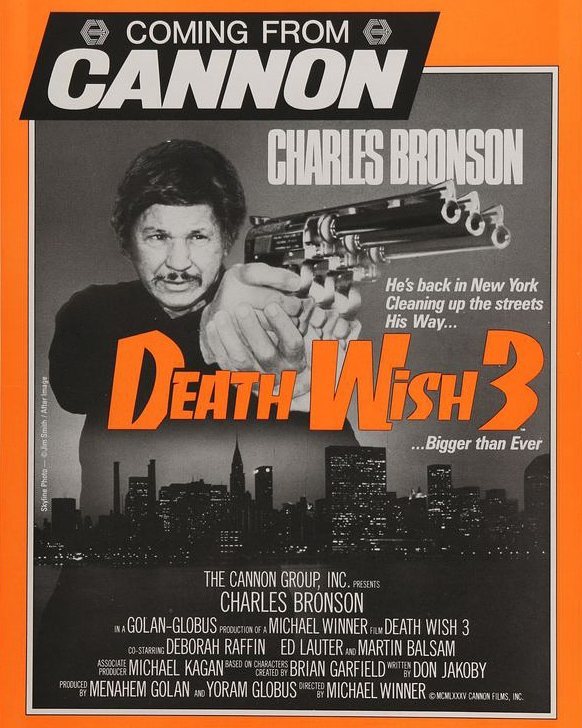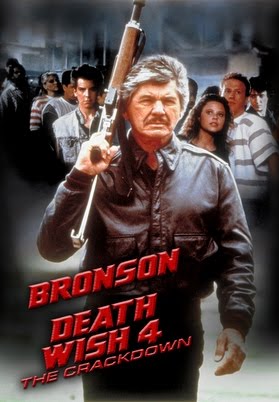When Death Wish was released in 1974, it polarized audiences with its depictions of violence and growing crime rates. It is not at all surprising that, although it took many years, sequels would arise. In total, five Death Wish films starring Charles Bronson were made, running from 1974-1994. A remake of the original film, starring Bruce Willis, is due for release in March 2018. I recently posted a flashback review for the original 1974 film, and in this review, will look at the second, third, and fourth installments (the fifth and final film in the original series, Death Wish V: The Face of Death, has never been given a Blu-ray Disc release in the United States, though I will most likely cover it in the future).
Following the release of the original movie, the rights to the Death Wish concept were purchased by cousins Menahem Golan and Yoran Globus, with the sequels produced by their company, Cannon Films, infamous for low-budget productions; one of their most infamous productions was the critically-panned Superman IV: The Quest for Peace, released in 1987. The fifth and final sequel, Death Wish V: The Face of Death, was produced by 21st Century Film Corporation, a company established by Menahem Golan after the bankruptcy of Cannon Films.
While the Death Wish sequels all met with varying degrees of success, none of them had the impact or the reputation of the 1974 original. In fact, they were panned by many critics, with some only drawing praise for a “so bad it’s good” quality. So, how are the sequels, really? Let’s take a look!
Death Wish II was directed by Michael Winner, who also directed the original 1974 film. It features a musical score from Jimmy Page (yes, THAT Jimmy Page), and the supporting cast includes Jill Ireland (Bronson’s real life wife), Vincent Gardenia, Thomas F. Duffy, Charles Cyphers, and an early appearance from an up-and-coming Laurence Fishburne (credited as “Laurence Fishburne III.”)
Several years have passed since the events of the original Death Wish film. Paul Kersey has settled down in Los Angeles, and is dating Geri Nichols, a local radio personality. His daughter is slowly recovering from the trauma she suffered in the first film. Paul has put his gun away, and life looks good, including his architectural career. But when thugs steal Paul’s wallet during a day out and he fights back, they use his driver’s license to find his address, breaking in and brutally raping and murdering his housekeeper, and abducting his daughter, who dies trying to escape the gangsters. Following the tragedy, Paul sets his sights on the thugs responsible, once again taking up the gun, and even getting a low-rent apartment in a shady neighborhood to pursue the criminals. But when rumors of a vigilante in Los Angeles spread, New York City Inspector Ochoa, who pursued Paul back in New York, takes a flight out to the California coast to see if Mr. Kersey is up to his old tricks again.
Okay, let’s be honest and realistic. Death Wish II is not as good as the original. But for what it is, it is a solid sequel that features Charles Bronson doing what he does best; blowing away thugs that absolutely deserve it. The score from former Led Zeppelin axeman Jimmy Page (which is NOT limited to guitars) is superior to the score Herbie Hancock composed for the original film, and does a solid job setting the atmosphere (I challenge you to tell me that guitar-heavy piece playing over the end credits isn’t the most bad-ass thing you’ve ever heard). The love story, with Paul trying to piece his life together, and the two of them juggling everything, has more substance than what would follow in subsequent sequels. The action sequences are solid, and despite its obvious low budget, the film impresses. The only major weaknesses of the film are that it, at times, does feel like a retread of the first film, the more “single-minded” approach Paul takes, and the fact he has, apparently, out of nowhere, become a competent hand-to-hand fighter.
In Death Wish movies, the highlight is always seeing Charles Bronson blow the street trash away, but here he sets his sights exclusively on the assailants responsible for the death of his daughter and housekeeper. There are some disappointing moments as a result of this; we see plenty of scumbags we wish he would kill, but this narrow-minded pursuit of vengeance this time around is a definite detractor. But on a more positive note, when he does act, we are not disappointed. The thugs include a young Laurence Fishburne, sporting a ghetto blaster and some laughable pink sunglasses, who ends up meeting a comical and well-deserved fate. Even the final fight against the leader of the gang has some unexpected twists that require Paul to use his brain as well as his wits.
I admire Death Wish II for having more substance than most of what would follow for this series. It is the only film after the original to have a truly believable love story (helped by the fact that she is played by his real life wife at the time, Jill Ireland, though he would only cast her on the stipulation that the muggers in the film not attack her). The juxtaposition of scenes with Paul blowing away the street trash and juggling his love life makes for some interesting viewing. It is also nice to see some scenes of Paul actually doing his architecture job, and not having it relegated to backstory (something I similarly praised the first movie for). This film has been bashed to hell over the years, but it is still a cut above other copycat vigilante movies, and still retains the gritty realism of the original, even if a few elements feel over the top. Even Vincent Gardenia as Ochoa (the only actor/character besides Bronson’s Paul Kersey to appear in more than one film) gets a chance to shine in a climactic scene that largely redeems the detestable but still likable character after his part in the original film.
That said, there are a few issues with the film. In a city as big as Los Angeles, Paul can somehow track down individual gangsters? (Keep in mind this was long before the advent of GPS and smart phones.) And when did Paul become a skilled fighter that is capable of holding his own against punks half his age? The moments of a “retread” feeling after seeing the original do exist, but fortunately, the movie brings enough to the table to keep things fresh.
Is Death Wish II the classic that the original movie is? Certainly not. But it is easily the best of the sequels, retaining the grittiness and violence of the original movie, with an interesting new setting and enemies to go after, even if a few elements do fall flat. If you like the original, this one is worth seeing as a worthy follow-up.
There have been multiple versions of the film released over the years. The American version has an edited rape scene, which had to be edited for the film to get an R rating in the United States. The initial Blu-ray release (and most earlier releases) have this edited version of the scene, but a reissue of the film from Shout! Factory has the option of viewing the edited R-rated cut of the movie, or the original unrated version (said scene is quite disturbing, arguably the worst of its kind out of all the Death Wish films).
Death Wish 3 is also directed by Michael Winner (it was the last Death Wish film he would direct), and co-stars Gavin O’Herlihy, Ed Lauter, Martin Balsam, and Deborah Raffin. Alex Winter (later Bill in the Bill and Ted movies) has a minor role as a gang member.
Paul Kersey has just arrived back in New York City, to visit an old war buddy. But upon arriving in the apartment, he finds his friend nearly dead from a gang attack, and is subsequently wrongfully arrested for his murder. In the jail, he encounters gang leader Fraker, and is violently berated by Shriker, the man in charge of the jail, but gets an unexpected opportunity. Shriker, knowing Paul’s past as a vigilante, will let him go free to begin cleaning up the neighborhood by any means necessary, in which crime has reached new heights due to Fraker’s gang members terrorizing the local populace. Getting new armaments including a big game pistol, machine gun, and a even a bazooka, he sets out to protect the locals and do his part to take down Fraker.
….and here is where the Death Wish series basically throws all semblance of reality out the window. In the first two movies, Paul Kersey was a man that took up arms when his family was threatened. Here he is basically turned loose in a “war zone” of a neighborhood with endless amounts of badly-dressed thugs that looks like rejects from The Warriors. Crime is at unrealistic heights, the police do not enforce the laws but harass the civilians, not providing help of any kind. The movie even tries to shoe horn in a love story between Paul and a public defender, but the execution is laughably bad and it feels like an afterthought. And since when can you get firearms and weapons through direct mail order? Death Wish 3 has often been called the best AND the worst film in this series. The worst because its over-the-top execution bares no resemblance to reality whatsoever, and the best for the very same reason; it basically lets Bronson cut loose and do his thing, whether he is blowing thugs away, or setting up Home Alone-esque traps to keep them out of the apartment building. If you want mindless, violent entertainment, Death Wish 3 delivers. If you want deeper movie like the original 1974 film, go watch that instead.
If nothing else, one can praise Charles Bronson’s portrayal of Paul Kersey, even if here he is basically given the keys to the kingdom and allowed to do what he wants with little or no consequence. Even over a decade after his first film in the role, we still can’t help but get a sense of satisfaction every time he kills an unsympathetic mugger or rapist with, pardon the bad joke, a death wish. The supporting cast has a few enjoyable performances, including Ed Lauter (this guy is in every damn movie ever made but is never the star) as Inspector Shriker, who turns Kersey loose on the bad side of town to bring down the gang, and Gavin O’Herlihy (the original Chuck Cunningham actor from the early episodes of Happy Days) as gang leader Fraker, who does an unrealistically good job of making you hate him throughout the course of the film (something O’Herlihy seems to do in nearly every role he plays, whether an abusive ex-boyfriend in Superman III, or a horse thief in Lonesome Dove, where Robert Duvall even told him he’s the kind of man it’s a pleasure to hang!) Even Martin Balsam (12 Angry Men, Psycho) has a memorable role as a landlord. You’ll be rooting when Fraker gets his just dues. And while he doesn’t get a substantial part, it is fun to see future Bill and Ted actor Alex Winter in an early role as one of the gang members.
Of course, outside of the performances and the action, there isn’t much else. The love story is laughably bad and rushed, with predictable consequences. The finale is over-the-top and good fun, but somehow, everyone in town suddenly seems to have guns even though they’re supposed to be illegal in New York? In Death Wish 3, action violence takes center stage, and depth takes a holiday. It’s good mindless fun, and you’ll be rooting for Bronson taking out the trash, but don’t come to this one expecting anything outside of that.
Death Wish 4: The Crackdown is directed by J. Lee Thompson (The Guns of Navarone, Conquest of the Planet of the Apes) and co-stars Kay Lenz, John P. Ryan, Perry Lopez, Soon-Tek Oh, and George Dickerson. The film also has appearances from Dana Barron (Audrey from National Lampoon’s Vacation) and Danny Trejo.
Paul Kersey is back in Los Angeles, and is dating a journalist. But when her daughter dies of a drug overdose, Paul goes after the ones responsible. Getting advice on targets to hunt from a newspaper magnate who seems to be aware of Paul’s vigilante past, he begins targeting kingpins in two rival gangs, turning them against one another, and assassinating their leaders. But there is more to the events at hand than meets the eye, as Paul will learn the hard way.
After the over-the-top antics of Death Wish 3, Death Wish 4: The Crackdown tries to bring things back to a more realistic and gritty feel, with Paul going against rival gangs and utilizing information, and in some cases, creative means to take out the thugs. Unfortunately, the love story once again feels like an afterthought, and the villains feel pulled from every other crime/mob/gangster movie ever made. There are some satisfying sequences, and it is honestly a decent film, but everything in this movie has been done better elsewhere.
The initial plot shows promise with a diverse band of villains, but quickly descends into being a second-rate crime movie that blatantly rips off Yojimbo and A Fistful of Dollars. After the first half hour or so, Paul’s girlfriend is tossed aside and forgotten, only to return at the end of the film after we have forgotten her, depriving the movie of a much-needed element. I will give the movie credit for a few unexpected plot twists; it is less predictable than earlier entries in this regard, but ultimately it feels like nothing new or remarkable. The film is serviceable and enjoyable, but not much else.
–
–
The Death Wish sequels, sans the fifth and final entry, have all been released on Blu-ray Disc by MGM/Fox, available separately and in a “Bronson Triple Threat” pack. All of the movies look and sound surprisingly well for their age. The second film, as was previously stated, has also been reissued by Shout! Factory in a separate package including the uncut version of the movie, and a handful of bonus features; MGM/Fox’s release have trailers as the only extra.
With the Death Wish remake on the way (which I am cautiously optimistic for), it is a fine time to go back and rediscover the original movies starting Charles Bronson. The original is a must-see as well as its immediate follow-up, but know what you are getting into when it comes to the sequels.
DISCLAIMER: All images seen in this film are for promotional purposes only, and are the property of their original copyright holders, including (but not limited to) Paramount Pictures, Warner Bros. Pictures, Menaham Golan and Yoran Globus, Cannon Films, Lionsgate, Columbia Pictures, and 20th Century Film Corporation. All rights reserved.




